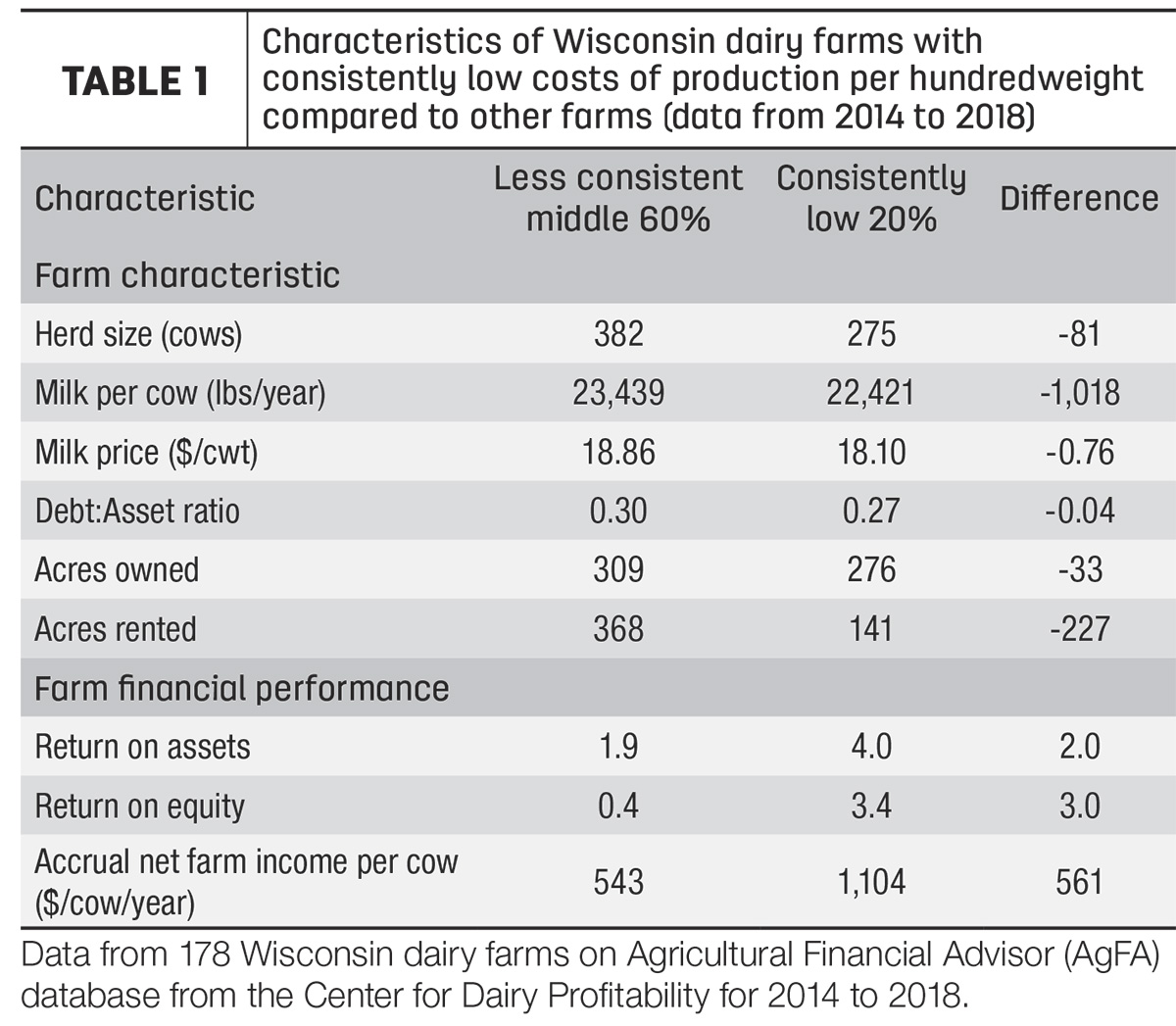In many aspects of life, it is hard to consistently be on top of your game. Professional sports teams sometimes win back-to-back championships, but it is not that common. Managing a dairy farm presents a constant series of challenges with a continuous need to respond to ever-changing market and production conditions.
A project recently funded by the University of Wisconsin’s Dairy Innovation Hub set out to explore patterns of costs of production per hundredweight among Wisconsin dairies, and in particular to explore how well the farms do at managing the costs of production over time given the never-ending challenges.
Using data from the Agricultural Financial Advisor (AgFA) database from the Center for Dairy Profitability for the years 2014 to 2018, we identified dairy farms that were consistently in the lowest 20% for cost of production per hundredweight. Of the 178 farms for which we have records, only 15 farms (8%) were in the lowest 20% during all five years. Although the proportion of farms is small, it doesn’t seem to be completely random. We would expect very few farms to be in the lowest 20% for all five years just by chance. This article looks at the characteristics and performance of those farms with consistently low costs of production per hundredweight and compares them to farms that were less consistent.
We considered the average values of key indicators for farm characteristics, profitability and production costs for the two groups of farms. Farms consistently in the lowest 20% category were compared to farms with less consistent costs of production per hundredweight. The comparison farms included the 60% of farms that were not consistently in the lowest 20% or the highest 20% for costs of production per hundredweight. This means that the comparison farms had a more variable cost of production per hundredweight performance over time than those consistently in the lowest 20% group. The data show that these comparison farms sometimes ranked in the lowest 20% for cost of production per hundredweight, sometimes in the highest 20% and sometimes in between the highest and lowest categories.
What are the characteristics of farms that are always in the lowest 20% category for cost of production per hundredweight? These farms had a smaller average herd size but with a broad range. The number of cows for the consistently low-cost farms ranged from 52 to 1,125, but nearly half of the farms had between 50 and 99 cows. The less consistent farms had from 20 to 2,219 cows, but farms with 100 to 199 cows were the most common. Perhaps surprisingly, the average milk per cow and milk price were lower than for less consistent farms (Table 1). The consistent farms also received a smaller proportion of revenues from crop sales, had somewhat lower debt-to-asset ratios, owned fewer acres and rented considerably fewer acres than less consistent farms.

The average financial performance on scale-neutral measures was better for the more consistent farms, with a higher return on assets, return on equity and net income per cow. It may seem strange that these farms had higher profitability when they had a lower milk price, but in this case that lower price was more than offset by the consistently lower costs of production per hundredweight. The available information doesn’t really allow us to assess why the more consistent farms had lower costs and higher profitability. Were the consistently low-cost farms pursuing a specific strategy, or did their results just come out this way for the five years we looked at? We plan additional work to understand this better.
We can also look at the differences in major cost categories for the consistent and less consistent farms (Table 2).

The farms with consistently lower cost of production per hundredweight had average cash operating costs about $2.40 per hundredweight lower than the less consistent farms during the 2014 to 2018 time period. Lower labor and purchased feed costs per hundredweight accounted for about half of this difference, although lower costs for rentals, machinery hire and repairs were also important. Adjustments for accrual accounting and interest expenses didn’t modify this basic picture very much. The average cost of production with these adjustments and additions is about $2.55 per hundredweight lower for the consistently low-cost farms. However, the consistently low-cost farms had higher costs per hundredweight for unpaid labor and management, resulting in an overall average cost of production about $1.80 per hundredweight lower.
Although our work suggests that a small percentage of farms achieved consistently lower costs of production per hundredweight during the five years we looked at, we also should be cautious when using cost of production per hundredweight as the only measure of performance. It is often said that farms should keep costs as low as possible if they produce a “commodity,” a product similar among farms and where farms generally cannot have much influence on the market price. However, a strategy that focuses only on the lowest possible cost could often be a bit too simplistic.
Keeping costs of production per hundredweight low is one strategy for success, but so is making investments that increase some costs but that also increase profitability by increasing revenues or lowering other costs. For example, it may improve profitability to improve cow feeding to increase the components in milk, even if feed costs per hundredweight are higher. Using debt effectively could result in a higher interest cost per hundredweight but lower overall costs of production per hundredweight. This means that it probably makes the most sense to keep an eye on the different components of production costs and the opportunities to enhance profitability.












